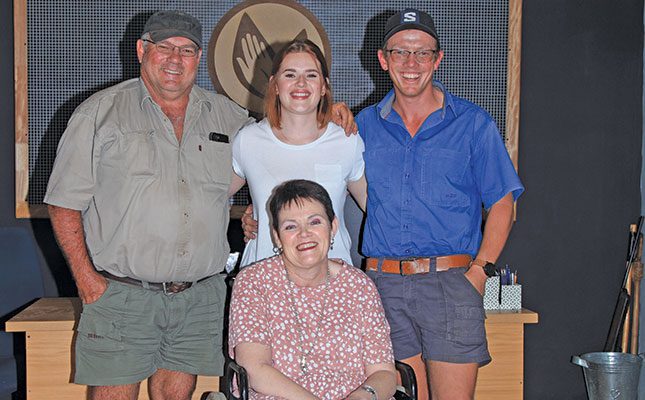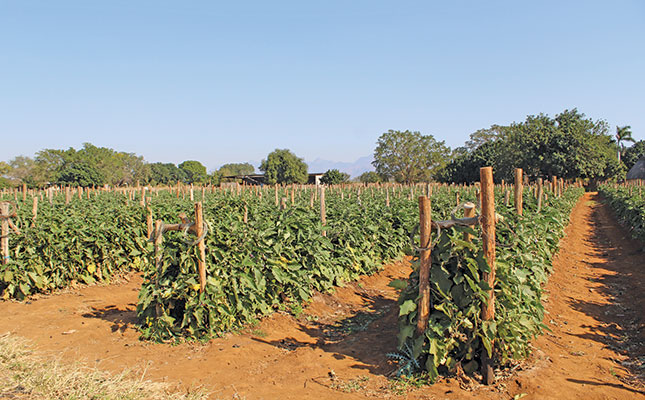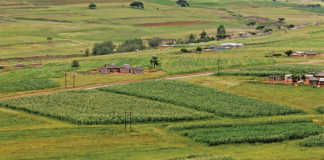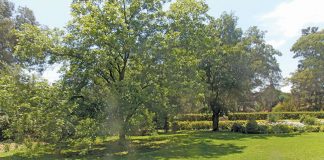
Photo: Glenneis Kriel
Unfavourable climatic conditions in the Orange River region this season have caused a significant drop in production on most wine, table grape and raisin farms.
According to Jacques Ferreira, manager of commercial industrial affairs at the South African Table Grape Industry, the region delivered 16,4 million 4,5kg-equivalent cartons of table grapes for export inspection this season. This was about 27% less than the previous season and about 17% less than the region’s five-year average.
The Orange River region produces 85% to 87% of South Africa’s raisin supply. Raisins South Africa reported that the country produced 78 757t of raisins last season, with production expected to decline to between 63 000t and 68 000t this season.
Charl du Plessis, CEO of Orange River Cellars in Upington, says that wine-grape production in the region averages around 35t/ ha, but was closer to 20t/ha this season.
Despite the decline in all three grape types, some farmers, such as father-and-son-team Lourens and Kobus Maass of GPA Boerdery near the town of Grootdrink, are still producing decent volumes.
Lourens says that during the 2021/22 season, they achieved 2,5t more raisins per hectare than the industry average, although the 2022/23 harvest was 19% lower than last season’s.
Nonetheless, the quality of their raisins was much better than the previous season, when many grapes were downgraded as a result of a downy mildew outbreak. Lourens adds that the improved quality more than made up for the reduced volume.
Their 2022/23 wine-grape production was 5% higher than last season’s, but about 10% lower than their long-term average.
Keeping it simple
Lourens and Kobus attribute their success to the fact that they do the basics well, which to them means “doing the right thing at the right time”.
“The poor economy, combined with the sharp increase in input costs, has made it too expensive to make mistakes or experiment with new trends.
“Instead, you have to use tried-and-tested [methods] and get help from fellow farmers and other experts to make well-informed decisions when you get stuck,” says Kobus.
Even so, they admit that some environmental factors counted in their favour. Lourens explains that about half of their vineyards are located above the floodline of the Orange River.
As a result, there is much better airflow in these vineyards than in those closer to the river or on the river islands. This in turn ensures that they are less susceptible to fungal diseases such as downy mildew, which was the biggest production challenge in the region over the past two seasons.
Their vineyards are also planted in shale soil, which dries faster than the clayish soil closer to the river. This makes it easier for them to access the vineyards to perform essential maintenance work.
Choose the right crops
Asked to expand on “getting the basics right”, Lourens says that the first step is to choose the best crops and cultivars for the production conditions.
GPA Boerdery currently has 14ha planted to wine grapes, 30ha to grapes for raisin production, and 20ha to pecan nuts.
“We used to have 30ha planted to table grapes, but stopped growing them in around 2012 because of the high risk of frost and rain at times when these varieties are particularly vulnerable.
“It also no longer made sense when we took into account rising input costs, increased competition, and the high export standards with which table grapes have to comply,” says Lourens.
He adds that there are no table-grape producers left in the eastern part of the region, where he and Kobus farm. Still, his experience with table grapes has taught him a lot.
“Most farmers who grew up producing table grapes tend to retain the diligence and precision with which we worked these vineyards. So when we switch over to wine grapes and [grapes for raisin production], we’re more in tune with what’s happening in our vineyards and how to use our inputs more efficiently.”
Turning to raisin production, he says that they have stopped farming sultanas, which in the past used to be the main variety for this use in the region. Sultanas, he explains, are sensitive to rain damage and have lower yields than some of the new and improved grape varieties, such as Selma Pete, Sugra 39 and Merbein, that he and Kobus now use. More than half their vineyards comprise the Flame Seedless cultivar.
“This can be produced for the table grape or [raisin] market, so we merely switched some of the old vineyards from table grape to raisin production, and have since planted more hectares. I’ll definitely plant more Flame Seedless in the future, because it gives good yields, produces good grades even when it rains, and performs better than any of the other varieties under our climatic conditions. Some of the others are prone to alternate bearing,” explains Lourens.
They graft most of their raisin varieties onto 143B MGT rootstocks, which are best suited for their deep clay lime soils. The remainder, their Shiraz and Chenin Blanc wine grapes planted in the shale soils above the floodline, are grafted onto Ramsey rootstocks.
The right thing at the right time
While downy mildew had a devastating impact on the grape harvests of the previous two seasons, Lourens successfully managed the risk in the 2022/23 season, thanks to his adviser, Francois Ozrovech, a crop-protection specialist at InteliGro.
“We used to start our downy mildew spraying programme after the rain, but two seasons ago, Francois advised me to begin earlier. I argued that it was unnecessary, and my failure to do so resulted in the disease having a severe impact on the quality of my grapes during the two seasons that followed,” admits Lourens.
In the season thereafter, they implemented a more rigorous programme than usual in mid-January, before any signs of infection, and this helped to reduce quality losses in 2022/23. They made as many as five fungicide applications to some vineyards, up until March. This season, they started with a downy mildew spore load that was lower than before, thanks to their stricter management and the drier conditions. For this reason, they reverted to a less intensive programme.
They alternate their fungicides to prevent the development of fungicide resistance.
Kobus points out that they don’t use copper sulphate to manage diseases.
“Systemic fungicides are translocated into the plant system, whereas contact fungicides like copper sulphate only destroy the fungi they come into contact with. A contact fungicide can make it look as if you’ve won the battle, only for you to discover a few days later that the problem is out of control.”
Consistency
It isn’t enough to simply do the right thing at the right time once and expect to reap the benefits on an ongoing basis. Actions need to be implemented consistently, over many years, says Lourens.
This starts with the establishment of new vineyards. “You need to do a soil analysis, correct nutritional deficiencies and prepare the soil properly before you plant. The vines you start with also need to be healthy and strong, because a sick vine will never perform as well as a healthy vine. From then on, you need to give the vines what they need at the right time.”
Soil samples are taken every three to four years to analyse the vines’ nitrogen, phosphate and potassium requirements. The Maasses’ fertilisation programme is adapted according to these results, the vines’ needs at different growth stages, and the crop loads at the end of each season.
“You aren’t only looking at the current season,” says Lourens. “You need to ensure that the vines have enough reserves to take them through the next one. Stress will makes vines more vulnerable to pests and diseases, and will prevent them from fulfilling their full genetic potential.”
Leaf samples are taken during the production season to identify trace-element deficiencies, which are corrected with foliar sprays.
“Don’t skimp on chemicals, fertilisers, water or pruning, as you’ll end up with lower yields and poor-quality fruit. My father, Gert, used to warn that ‘you can save yourself into bankruptcy’ by trying to cut costs.
“On the other hand, these inputs should be used correctly and as precisely as possible so you don’t waste money.”
Caring for the environment
Lourens and Kobus use chemical pest-management solutions as sparingly as possible in an effort to avoid disturbing the biodiversity on the farm.
“We don’t have many pest problems under normal conditions, thanks to our dry climatic conditions. Our average annual rainfall is around 160mm,” explains Lourens.
Nevertheless, Sugra 39 and Selma Pete are vulnerable to leafhoppers, so are treated preventatively with a single insecticide application every November.
“We have to keep leafhoppers under control, or they’ll destroy the ‘factory’ of the plant by sucking the leaves dry,” he adds.
The Maasses also have a set programme to manage rust, and adapt it according to the risk and the severity of the problem.
“With rust, we’ve learnt to spray before flowering, otherwise we lose money,” says Lourens.
Keep it cool
Weeds are left in the vineyards as soil cover. “Temperatures here can reach above 40°C, which bakes the soil. The weeds help to keep the soil cool, preventing it from drying out and protecting soil organisms.” The weeds are mulched when they grow too high.
A problem often experienced with cover crops is that they compete with the vines for water. This is not a problem on the Maasses’ farm, as they have sufficient water. What’s more, roughly half of their vineyards are under flood irrigation, while those away from the floodline are under either drippers or micro-sprinklers, depending on the soil type.
Kobus explains that vineyards where the soil has lower water-holding capacity have micro-sprinklers to ensure that enough water is delivered on hot days, while those where the soil has greater water-holding capacity are fitted with drippers.
While the use of micro-sprinklers and drip irrigation is more water-efficient than flood irrigation, flood irrigation is a saviour during load-shedding, as the water is delivered via gravity, not electricity, to the farm. As a result, the farm does not have to incur extra costs in the form of generators to provide irrigation at the right times.
Farm the light
The success of a harvest is greatly influenced by vine management. Kobus says the aim of their summer pruning is to “open up” the vineyards to ensure good light penetration and air movement.
“You need the light to penetrate the canopy to ensure the vines’ future fertility. The good airflow helps to prevent the development of fungal diseases,” he explains.
Their winter pruning strategy depends on the vigour of the variety in question. With some, all the bearers are shortened; with others, four to six are left. Most of their vines are pruned to four short bearers per side, as the new varieties are much more vigorous than the older ones.
Kobus says his grandfather used to say that “a wire doesn’t carry any grapes”, so they try to cover the whole wire with branches.
“We twist the bearers around the wire, which seems to activate the budding process.”
Where some farmers start pruning in May, the Maasses prune quite late in the season, towards the third week of July.
“The trend is to prune later in the season. For us, it helps to stretch the harvest period by a week or two,” says Kobus.
A team of about 40 well-trained workers make certain that everything is done on time, with two controllers moving up and down the vineyards to ensure that the vines are pruned correctly and to address problems as they arise.
Succession planning
Good succession planning is another requirement to ensure the future of a farm. Lourens points out that his grandfather, also Lourens, was one of the first farmers in the region in the 1930s, and Kobus is now the fourth generation on the farm.

Kobus, who is in his late twenties, grew up on the farm and joined the operation straight after finishing high school in 2013.
Father and son enjoy farming together. “We make a good team, as Kobus is quite hands-on in the office and on the marketing side, whereas I like being outside, in the middle of the action on the farm,” says Lourens.
He adds that the challenge for farmers growing older is to give the next generation leeway to operate as they see fit.
“It’s easy to become set in your ways, but you need to have an open mind and give your [child] room to make mistakes and find [their] own way.”
Kobus says communication is the key to the success of this kind of relationship.
“We argue like cat and dog some days, but in the end we put our differences aside because we realise that both of us want what’s best for the business.”
Email Lourens Maass at [email protected].










